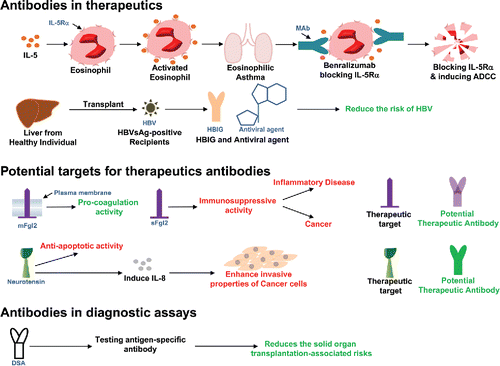Antibodies entered the mainstream of pharmaceutical industry, biotechnology, and life sciences in many different ways. This issue of the International Reviews of Immunology is dedicated to novel potential targets for antibody therapy and utilization of antibodies as companion biomarkers.
Uncontrolled eosinophilic asthma remains an unmet medical need. Because eosinophils are key effector cells in asthmatic airway inflammation, blocking IL-5, the main cytokine responsible for their survival and activation, is of significant interest from a therapeutic perspective. In the first review, Khorasanizadeh et al. provided a perspective on benralizumab, a monoclonal antibody against IL-5Rα that carries significant promise for treatment of eosinophilic asthma. Interestingly, this antibody that just showed positive results in phase 3 clinical trials, in addition to a receptor-blocking activity, has also an antibody-dependent cell-mediated cytotoxicity (ADCC) function that may lead to depletion of eosinophils. In addition to the applicability of this antibody to asthma, the authors discuss its potential role in chronic obstructive pulmonary disease.
FIGURE 1. Antibodies in translational medicine. Mab: Monoclonal antibodies; ADCC: Antibody-dependent cell mediated cytotoxicity; HBV: Hepatitis B Virus; HBIG: Hepatitis B Immunoglobulin; mFgl2: membrane-associated Fibrinogen-like protein 2; sFgl2: secreted Fibrinogen-like protein 2.

Much progress occurred in the management of Hepatitis B Virus (HBV), especially due to the advent of potent anti-viral agents (nucleoside analogs) such as lamivudine, adefovir, tenofovir, or entecavir. Nevertheless, there is still debate in regards to how best one should go about prevention of HBV recurrence after liver transplantation in HBVsAg-positive recipients. Rezaei et al. argued that Hepatitis B immunoglobulin HBIG remain significant in the era of new potent nucleoside analogs for prophylaxis against Hepatitis B recurrence after liver transplantation. The authors review different regimens including HBIG and antiviral mono therapy, a combination of HBIG with antivirals, and withdrawal of HBIG and whole prophylaxis of HBV recurrence in this patient population. In high-risk patients intramuscular or subcutaneous HBIG in combination with an antiviral, most commonly lamivudine, is still considered the standard of care.
There are common examples in biology of molecules with pleiotropic biological activity. Fibrinogen-like protein 2 (Fgl2), a member of the fibrinogen family, can be expressed as a membrane-associated protein with pro-coagulation activity, or in a secreted form possessing unique immune suppressive functions. Li and collaborators discussed the potential role of Fgl2 in inflammatory diseases and cancer and build a rationale for considering this molecule as a therapeutic target. This approach follows the typical path by which many molecules upon being initially established as disease biomarkers, became subsequently therapeutic targets.
In a different review in this issue of the journal, Ye et al. discussed Neurotensin, a molecule at the border between inflammation and tumor invasion via controlling epithelial–mesenchymal transition. Neurotensin is a component of a growing family of neuropeptides, soluble factors regulating a series of functions in the central nervous system. Some of these molecules are also pleiotropic and have also been demonstrated to stimulate the proliferation and migration of tumor cells. Specifically, Neurotensin has anti-apoptotic activity and stimulates a pro-inflammatory environment conducive to tumor cell migration via induction of IL-8 production. The authors discussed the merits of Neurotensin as a therapeutic target based on the accumulating evidence.
At last but not least Daniele Focosi discusses advances in pre-transplant donor-specific antibody (DSA) testing as a means to optimize solid organ transplantation by minimizing the risk of tissue incompatibility from an immunological standpoint. Currently, there is poor consensus on how to exactly estimate the global immunological risk, and most transplant centers adopt complicated internal guidelines for risk stratification. The author reviews published evidences that should drive appropriateness in risk stratification, focusing on donor-specific antibodies against HLA and other antigens. Nowadays, DSA are known to target not only HLA antigens, and a wide array of diagnostic assays is available.
Next issues of the journal will focus on a broad range of topics including basic research and translational progress regarding innate and adaptive immunity.
